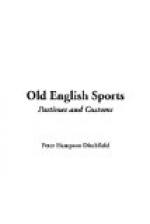Trap-ball is a much older game than cricket, and can be traced to the beginning of the fourteenth century. The modern game differs little from that which the old pictures describe, except in the shape of the trap which holds the ball. But the most ancient of all games of this nature is golf, or goff (as it used to be spelt), which was played with a crooked club or staff, sometimes called a bandy. Scotsmen are very fond of this game, which has lately migrated into England and found many admirers. It was probably introduced into Scotland from Holland, and was a popular pastime as early as 1457. In spite of proclamations encouraging archery, and forbidding golf, it continued to flourish; it has a long list of royal patrons; and the Stuart monarchs seem to have been as enthusiastic over the game as all true golfers ought to be. Poets have sung the praises of golf, and the glory of the heroes who drove their balls along St. Andrew’s Links, or those of East Neuk. The object of the game is to drive the ball into certain holes in the fewest number of strokes. James II. was an expert golfer, and had only one rival, an Edinburgh shoemaker, named Paterson.
[Illustration: PALL-MALL.]
If you have visited London you will probably have walked along the street called Pall Mall, which name is derived from an old game fashionable in the reign of Charles II. The merry monarch and his courtiers frequently amused themselves with this game, which somewhat resembled golf, and consisted in driving a ball by means of a mallet through an iron hoop suspended from the ground in the fewest blows. The game was played in St. James’s Park, where the street which bears its name now runs.
Tennis also has a history. It commenced its career as hand-ball, the ball being driven backwards and forwards with the palm of the hand. Then the players used gloves, and afterwards bound cords round their hands to make the ball rebound more forcibly. Here we have the primitive idea of a racket. France seems to have been the original home of tennis, which in the thirteenth century was played in unenclosed spaces; but in the fourteenth it migrated to the towns, and walls enclosed the motions of the ball. In Paris alone there were said to be eighteen hundred tennis-courts. In the sixteenth century there were several covered tennis-courts in England, and some of our English monarchs were very devoted to the game. Henry VII. used to play tennis, and there is a record of his having lost twelvepence at tennis, and threepence for the loss of balls. Henry VIII. was also very fond of the game, and lost much money at wagers with certain Frenchmen; but, like a sensible man, “when he perceived their craft he eschewed their company, and let them go.” He built the famous court at Hampton, which still remains. Charles II. also played tennis. The old game is very different from the modern lawn-tennis which is now so popular: it was always the game of the select few, and not of the many, like its precocious offspring; and there are only thirty-one tennis-courts in England at the present day. The court attached to the palace of the French King Louis XVI. at Versailles was the scene of some very exciting meetings in the early days of the French Revolution in 1789.




